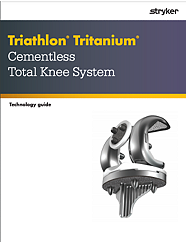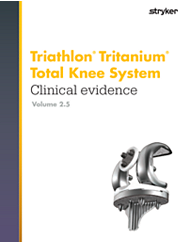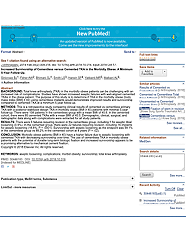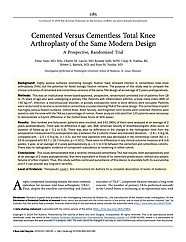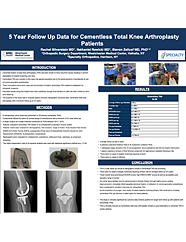Triathlon Tritanium
Cementless Total Knee System
Cementless total knee arthroplasty (TKA) with Triathlon Tritanium is the latest evolution in the Triathlon knee portfolio. Triathlon Tritanium combines the kinematics of Triathlon with the latest in highly porous biologic fixation technology. Tritanium's innovative tibial baseplate and metal-backed patella components are SOMA-designed and enabled by Stryker's proprietary Additive Manufacturing technology.

Why cementless TKA?
Encouraging outcomes for challenging patient demographics
Patient demographics for TKA have become younger and heavier,1,2 and these patients have demonstrated higher risk of revision in TKAs.3-5 When biologic fixation is achieved, cementless TKA has the potential for a more durable bone-implant interface that can better withstand the added mechanical stress in obese patients.6 In a retrospective study with 193 patients with a minimum of five-year follow-up, morbidly obese (BMI ≥40) patients receiving cementless primary Triathlon TKA with a PS design demonstrated improved survivorship compared to those who received a cemented Triathlon TKA.5 Furthermore, the American Joint Replacement Registry reported male patients younger than 65 years adjusted for age receiving a cementless TKA showed a better survivorship than those who received cemented TKA; however the difference is small (<1%) and does not account for other potential confounders.7
Potential savings in time and cost
As the volume of TKA procedures continues to increase, the costs associated with this surgical procedure continue to be an important topic. Cementless TKA allows the potential to reduce operating room time8,9 and save expenses without the use of bone cement and cement accessories.10 A healthcare economic study in the U.S. concluded that the actual overall cost of cementless TKA could be offset by shortened operating room time and the lack of need for cement and cementing accessories.10
Strong clinical evidence
Cementless TKA is growing in popularity.7 The 2019 National Joint Registry Report in the U.K. supports the long-term outcome of cementless femoral components,11 and the AAOS evidence-based clinical practice guideline found strong evidence suggesting similar functional outcomes between cemented and cementless tibial baseplates.12 Triathlon Tritanium cementless TKA demonstrated excellent clinical outcomes in multiple studies with five-year follow-up12,14 and achieved similar functional outcomes as well as pain reduction compared to cemented Triathlon TKA in multiple short- to midterm studies.8,19
| Outcome | Source |
|---|---|
99.5% implant survivorship in 228 Triathlon Tritanium Baseplates at five-year follow-up.13 |
Tarazi et al. Journal of Knee Surgery. 2020 |
100% aseptic survivorship in 28 Triathlon Tritanium Baseplates with CR PA beaded femur at five-year follow-up.14 |
Silverstein et al. Orthopaedic Research Society 2020 Annual Meeting. |
98% all-cause survivorship in 261 Triathlon Tritanium Metal-Backed Patella at 4.5-year follow-up.15 |
Harwin et al. Journal of Knee Surgery. 2020 |
99.5% all-cause survivorship in 1024 Triathlon PS cementless TKA at four-year follow-up.16 Both Tritanium and PA beaded versions of the tibial baseplate and metal-backed patella were included. |
Harwin et al. Journal of Arthroplasty. 2017 |
99% all-cause survivorship in 708 Triathlon Tritanium TKAs at two- to four-year follow-up.17 Tritanium Baseplate, Tritanium Metal-Backed Patella and PS PA beaded femurs were used. |
Bhowmik-Stoker et al. 2018 World Arthroplasty Congress. |
100% all-cause survivorship in 72 Triathlon Tritanium TKAs at mean three-year follow-up.10 Tritanium Baseplate, Tritanium Metal-Backed Patella and CR PA beaded femurs were used. |
Cohen et al. Orthopedics. 2018 |
No revision due to aseptic or septic loosening of Triathlon Tritanium Baseplate at two-year follow-up.18 |
Masini et al. American Academy of Orthopaedic Surgeons (AAOS) 2019 Annual Meeting poster. #2263 |
A prospective, randomized controlled study of 76 Triathlon Tritanium Baseplates with CR PA beaded femurs vs. 65 Triathlon CR cemented TKAs demonstrated excellent clinical results with no aseptic loosening in either cohort at two-year follow-up.8 |
Nam et al. Journal of Bone and Joint Surgery. 2019 |
Matched comparison of 200 Triathlon Tritanium Baseplates with PS PA beaded femur vs. 200 Triathlon PS cemented TKAs showed similar functional and survivorship outcomes between two cohorts with 99.95% aseptic survivorship for Triathlon Tritanium baseplate at mean 2.4 year follow-up.19 |
Miller et al. Journal of Arthroplasty. 2018 |
- Memtsoudis et al. Trends in demographics, comorbidity profiles, in-hospital complications and mortality associated with primary knee arthroplasty. J Arthroplasty. 2009;24(4):518-527
- Pabinger et al. Utilization rates of knee-arthroplasty in OECD countries. Osteoarthritis and Cartilage 2015; 23: 1664e1673
- Johnson et al. Patient Demographics as a Predictor of the Ten year Survival Rate in Primary Total Knee Replacement. The Journal of Bone and Joint Surgery 2003 85.1 pp. 5256
- Schreurs et al. Total Joint Arthroplasty in Younger Patients: Heading for Trouble? The Lancet (2017), volume 389, Issue 10077, P1374-1375.
- Abdel et al. Increased aseptic tibial failures in patients with a BMI 35 and well-aligned total knee arthroplasties. J Arthroplasty 2015;30:2181e4.
- Sinicrope et al. Increased survivorship of cementless versus cemented TKA in the morbidly obese. a minimum 5-year follow-up. J Arthroplasty. 2019;34(2):309-314
- American Joint Replacement Registry (AJRR): 2019 Annual Report. Rosemont, IL: American Academy of Orthopaedic Surgeons (AAOS), 2019
- Nam D., et al. Perioperative and Early Postoperative Comparison of a Modern Cemented and Cementless Total Knee Arthroplasty of the Same Design. The Journal of Arthroplasty 32 (2017) 2151-2155
- Cohen et al. Early clinical outcomes of a new cementless total knee arthroplasty design. Orthopedics. 2018;41(6):e765-e771.
- Yayac et al. The use of cementless components does not significantly increase procedural costs in total knee arthroplasty. J Arthroplasty. 2020;35(2): 407-412.
- National Joint Registry for England, Wales and Northern Ireland and Isle of Man. 16th Annual Report. 2019.
- American Academy of Orthopaedic Surgeons (AAOS). Surgical management of osteoarthritis of the knee. Evidence-based clinical practice guideline. 2015;https://www.aaos.org/globalassets/quality-and-practice-resources/surgical-management-knee/smoak-cpg_4.22.2016.pdf
- Tarazi et al. Mont MA, Harwin SF. Cementless Tritanium Baseplate total knee arthroplasty: survivorship and outcomes at 5-year minimum follow-up. J Knee Surg. Accepted manuscript. Published online June 19, 2020.
- Silverstein et al. 5 year follow up data for cementless total knee arthroplasty patients. Poster presented at: Orthopaedic Research Society (ORS) 2020 Annual Meeting; February 8-11, 2020; Phoenix, AZ.
- Harwin et al. Outcomes of cementless-backed patellar components. J Knee Surg. Accepted manuscript. Published online May 29, 2020.
- Harwin et al. Outcomes of newer generation cementless total knee arthroplasty: beaded periapatite-coated vs highly porous titanium-coated implants. J Arthroplasty. 2017;32(7):2156-2160.
- Bhowmik-Stoker et al. Clinical performance of a novel 3D printed cementless titanium tibial baseplate, 2-4 year follow-up. Presented at: 2nd World Arthroplasty Congress; April 19-21, 2018. Rome, Italy.
- Masini et al. Cementless total knee arthroplasty resulting in no revisions due to tibial component loosening and improved outcomes. Presented at: American Academy of Orthopaedic Surgeons (AAOS) Annual Meeting. March 24-28, 2018. Orlando, FL.
- Miller et al. Results of cemented vs cementless primary total knee arthroplasty using the same implant design. J Arthroplasty. 2018;33(4):1089-1093.
TRITAN-WC-6_Rev-1_26055

